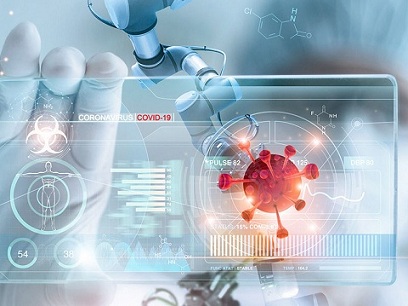University Of Texas Study Discovers That SARS-CoV-2 Utilizes Metal-Dependent Mechanism To Evade Immune Detection In The Human Host Body!
Source: COVID-19 Research Jun 05, 2021 4 years, 6 months, 1 week, 6 days, 13 hours, 45 minutes ago
COVID-19 Research: A new ground breaking research by scientists from the University of Texas Health Science center at San Antonio has alarmingly discovered that the SARS-CoV-2 coronavirus is able to utilize the changes in metal ion concentrations to disguise itself in the human host body thus evading immune responses.

According to the study abstract, “The SARS-CoV-2 nsp16/nsp10 enzyme complex modifies the 2′-OH of the first transcribed nucleotide of the viral mRNA by covalently attaching a methyl group to it. The 2′-O methylation of the first nucleotide converts the status of mRNA cap from Cap-0 to Cap-1, and thus, helps the virus evade immune surveillance in host cells.”
The study team reported two structures of nsp16/nsp10 representing pre- and post-release states of the RNA product (Cap-1). They observed overall widening of the enzyme upon product formation, and an inward twisting motion in the substrate binding region upon product release. These conformational changes reset the enzyme for the next round of catalysis. The structures also identify a unique binding mode and the importance of a divalent metal ion for 2′-O methylation.
The study team also described underlying structural basis for the perturbed enzymatic activity of a clinical variant of SARS-CoV-2, and a previous SARS-CoV outbreak strain.
The study findings were published in the peer-reviewed journal: Nature Communications.
https://www.nature.com/articles/s41467-021-23594-y
Interestingly, varying concentrations of metal ions ie positively charged atoms such as magnesium, manganese and calcium, were observed in hospitalized COVID-19 patients.
Senior author Dr Yogesh Gupta, PhD, an assistant professor of biochemistry and structural biology at the UT Health Science Center San Antonio and investigator with its Greehey Children's Cancer Research Institute to;d Thailand Medical News, "This is a newly described metal-dependent mechanism by which these ions help the virus to evade immune surveillance."
Dr Gupta and colleagues captured atomic-level snapshots during various stages of camouflaging activity of the coronavirus.
Importantly Ii turns out metal ions have an architectural purpose ie they form a bridge between viral messenger RNA (which are instructions for encoding the virus) and a protein complex consisting of viral proteins nsp16 and nsp10. The activity is sort of like a scaffold swaying in the wind and workers laying hands on it to steady it.
It was found that with the scaffold stabilized, the virus then uses nsp16 to modify its messenger RNA cap into a Trojan horse unrecognizable to the immune system.
This tricks the defenses, protects the RNA code from being degraded and enhances viral growth in the body. This activity is required each time the virus multiplies.
It was also found that the nsp16/nsp10 protein complex stretches itself when the RNA cap is modified, which is a second finding the scientists reported. The stretching is facilitated by metal ion binding.
The unique role of a divalent metal ion in SARS-CoV
-2 nsp16 appears to be architectural, yet it is essential for accurate and efficient 2′-O methylation of the first transcribed base of the SARS-CoV-2 genome. With Cap-1’s important role in evading host innate immune response, the dependence and preference of nsp16/nsp10 for divalent metal ions also suggests that an imbalance in cellular metal concentrations could influence host innate immune response to infections by various CoVs.
In support of this hypothesis, hypocalcemia is considered as a strong predictor of in-hospital COVID-19 deaths, and severely ill COVID-19 patients had significantly lower magnesium levels in the blood.
https://link.springer.com/article/10.1007/s12020-020-02383-5
https://www.tandfonline.com/doi/abs/10.1080/07435800.2018.1433200
https://faseb.onlinelibrary.wiley.com/doi/full/10.1096/fj.202002346RR
One possibility is that the sub-optimal cap 2′-O methylation activity of the nsp16/nsp10 variants, together with altered levels of divalent metals, could trigger excessive immune response and cause hypercytokinemia in a subpopulation of COVID-19-positive patients.
More detailed studies should determine the direct correlations between RNA capping, metal levels in the host cellular milieu, and innate immune response.
The current study findings however can eventually aid in the development of treatment protocols for of all types of coronaviruses.
Dr Gupta added, “The next step is to use this structural knowledge to develop novel therapies to treat COVID-19 and emerging coronavirus infections. We are already studying how imbalances in metal concentrations regulate the host immune response to these infections."
For the latest
COVID-19 Research, keep on logging to Thailand Medical News.
